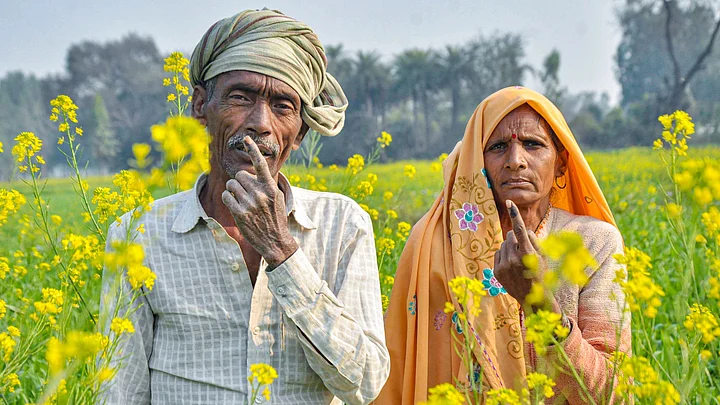The 2022 Assembly elections in Punjab, which was held on Sunday, 20 February, saw a voter turnout of 69.65 percent till 5 pm. The state of Uttar Pradesh too saw its third phase of Assembly elections on this day for which over 61.61 percent votes were registered till 5 pm, according to official data, reported PTI.
The figures are as per the polling data updated by Election Commission's Voter Turnout App at mid-night.
The third phase of polls in Uttar Pradesh covered 16 districts and 59 Assembly constituencies spread across Bundelkhand, Awadh, and western UP, while the single phase elections in Punjab were held for all 117 assembly seats across 23 districts.
The final polling figure in Punjab is expected to be less than 77.4 percent recorded in its 2017 Assembly polls, according to The Indian Express.
Results for the elections will be announced on 10 March along with the poll results for Uttarakhand, Goa and Manipur.
While 627 candidates were in the fray to contest for the third phase of Uttar Pradesh elections for the 403 member assembly, a total of 1304 candidates including 93 women and two transgenders contested for the Punjab polls.
'Rural Areas Saw Higher Polling Than Urban Ones' in Punjab
Speaking to IANS about the voter turnout in Punjab, an election officer said, "The voter turnout was 70 per cent with chances of the final figures likely to increase marginally. Rural areas saw high percentage of polling compared to urban ones."
Mansa district of Punjab recorded a maximum voter turnout of 77.21 percent while the lowest polling of 62.41 percent was seen at Mohali. Meanwhile, among the Assembly seats, the Talwandi Sabo assembly segment saw the highest turnout of 83.67 percent while the Amritsar West witnessed the lowest polling at 50.10 percent.
Except some incidents of minor clashes, no major poll-related violence has been reported in the state of Punjab so far, reported IANS.
Amritsar was among the districts that saw the lowest voter turnout in Punjab. Amritsar East that saw the most high-profile contest between the Navjot Singh Sidhu of the Congress and Bikram Singh Majithia from Akali Dal recorded a polling percentage of 53 percent, reported The Indian Express.
AAP strongholds in Malwa region from where the party won 20 seats in 2017 too saw a low voter turnout. The region's Gidderbaha received the highest voter turnout of 77.80 percent. The voter turnouts at Bathinda, Faridkot, Mansa, Muktsar, Barnala and Sangrur districts were lower than the polling in 2017.
Bhadaur and Chamkaur Sahib from where Punjab Chief Minister Charanjit Singh Channi contested saw a voter turnout of 71.30 percent and 70 percent, respectively till 5 pm. The constituency of Dhuri from where Bhagwant Mann, AAP's CM face stood for elections saw a polling of 68 percent till 5 pm.
Lambi and Jalalabad, the bastions of Badals from where former CM Parkash Singh Badal and SAD president Sukhbir Singh Badal contested, recorded a voter turnout of 72.40 percent and 77 percent, respectively.
The city of Patiala from where former CM Capt Amarinder Singh seeks to be re-elected saw a polling of 62.10 percent.
At 71.5 percent, the Assembly seat of Pathankot's Sujanpur – a BJP stronghold – witnessed the highest polling percentage in Majha region.
Highest Turnout in Lalitpur, Lowest in Kanpur Nagar
In Uttar Pradesh, till 5 pm, the highest voting of 69.61 percent was recorded at Lalitpur and the lowest polling of 56.14 percent was seen in Kanpur Nagar.
The 16 districts that went to the polls in the third phase included Firozabad, Mainpuri, Etah, Kasganj, Hathras, Kanpur, Kanpur Dehat, Auraiya, Kannauj, Etawa, Farrukhabad, Jhansi, Jalaun, Lalitpur, Hamirpur, and Mahoba.
During the Assembly elections in 2017, Punjab saw a voter turnout of 77.4 percent while the polling percentage for 59 seats of UP was 62.21, that year.
Background
In Punjab, the main contest is among the ruling Congress, the Aam Aadmi Party (AAP), and the Shiromani Akali Dal (SAD), which is contesting the polls in alliance with the Bahujan Samaj Party after breaking two-decade old ties with the BJP in 2020 over the farm laws. The BJP-Punjab Lok Congress (PLC) alliance is also in the fray, besides the Sanyukt Samaj Morcha, comprising Punjab farmer bodies that had taken part in the agitation against the Centre's now repealed agricultural laws.
In the 2017 Assembly elections, the Congress had won an absolute majority by winning 77 seats in the 117-member Assembly, ousting the SAD-BJP government after 10 years.
The AAP had emerged as the second-largest party, winning 20 seats. Shiromani Akali Dal (SAD) won 15 seats, while the BJP, which had a coalition government with the Akali Dal in Punjab from 2007 to 2017, secured three seats.
In Uttar Pradesh, the Bharatiya Janata Party (BJP) had swept Bundelkhand in 2017, the Samajwadi Party (SP) considers at least eight districts in this region – Mainpuri, Etawah, Firozabad, Kasganj, Etah, Farrukhabad, Kannauj, and Auraiya – as its strongholds.
SP chief and former CM Akhilesh Yadav contested his maiden Assembly election from Karhal in Mainpuri against Union Minister and BJP candidate SP Singh Baghel on Sunday.
(With inputs from PTI, IANS, India Today, The Indian Express)
(At The Quint, we question everything. Play an active role in shaping our journalism by becoming a member today.)
